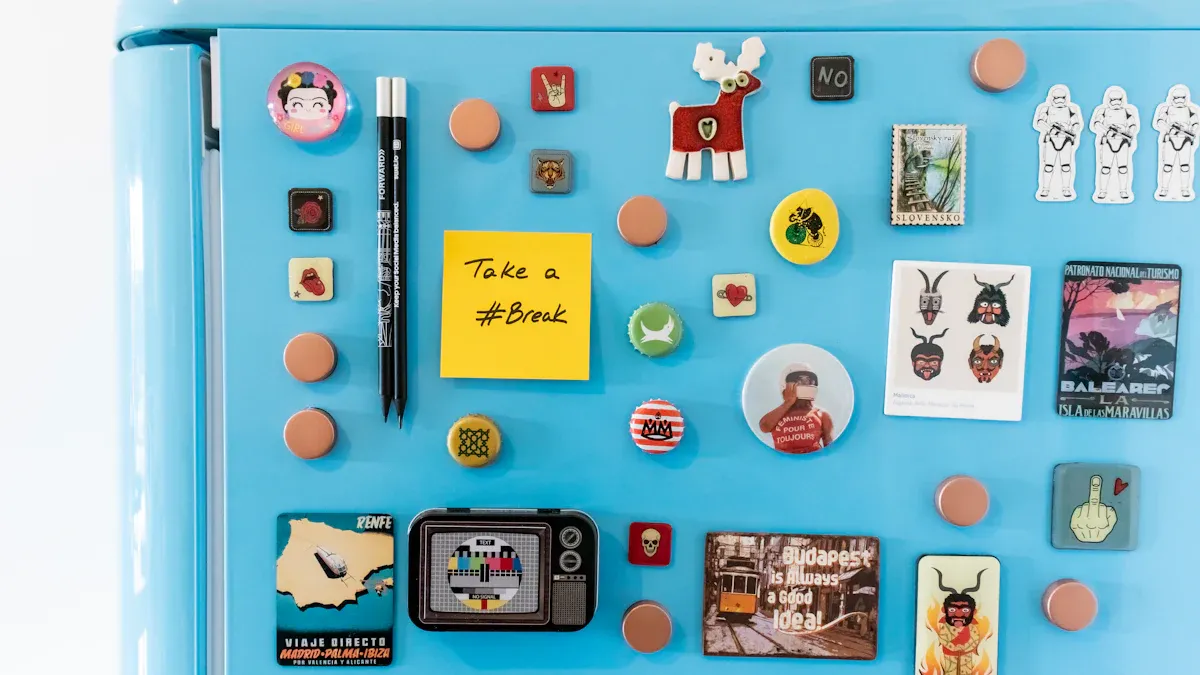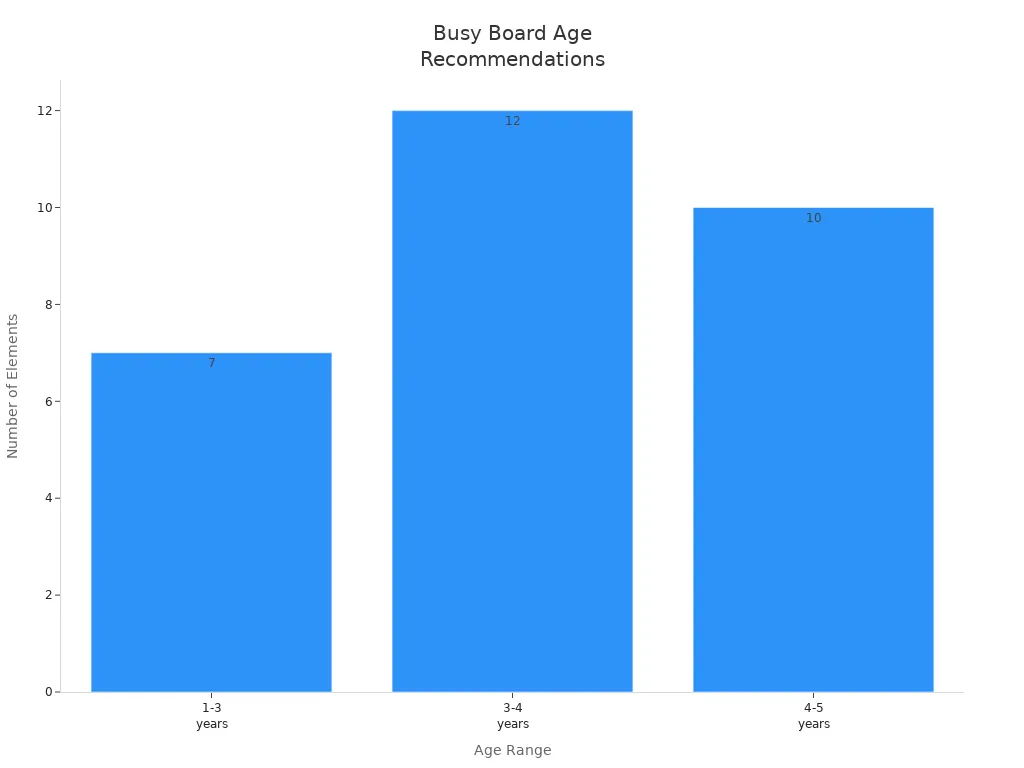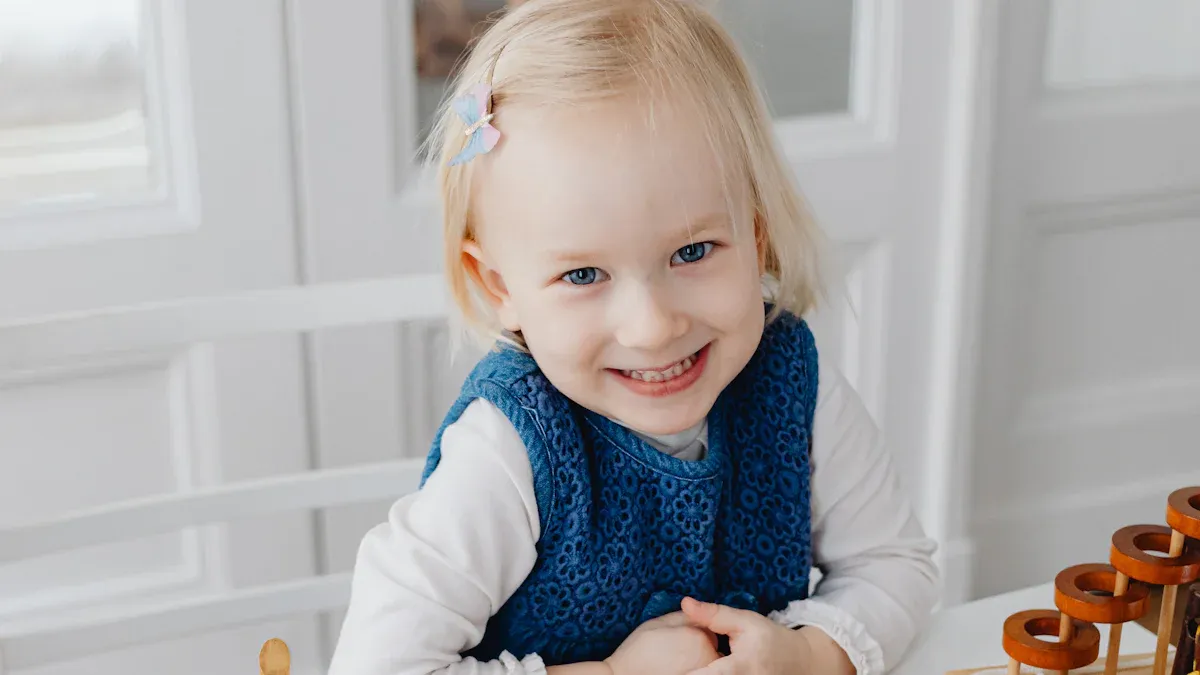A busy board gives your child a hands-on way to learn and play. You see buttons, latches, and zippers that help teach practical life skills. Your child explores their world with curiosity and builds confidence. Picking the right board keeps playtime safe and supports healthy development. If you want to make a smart choice, this guide will walk you through everything you need to know.
Key Takeaways
-
Busy boards help kids learn by using their hands. They build motor skills and thinking skills. Kids also learn to do things on their own.
-
Pick a busy board that fits your child's age. Make sure it matches what your child likes. This helps your child learn more and stay interested.
-
Find boards made with safe materials. Make sure the board is strong and will last. Choose features that your child can use as they grow.
-
Check the busy board often for loose parts. Look for anything that could be unsafe. This keeps playtime safe and fun.
-
Try busy boards with themes to make learning exciting. Themed boards help your child use their imagination and stay curious.

What Is a Busy Board?

Purpose and Benefits
A busy board is more than just a toy. You can think of it as a hands-on learning tool packed with everyday objects like ribbons, knobs, and switches. Early childhood experts say that a busy board helps your child develop important skills by letting them interact with real household items. When your child plays with a busy board, you get a little break while they stay engaged and curious.
Here’s what a busy board can do for your child:
-
It acts as an educational instrument that supports your child’s development.
-
It helps your child build motor skills by using different fixtures and objects.
-
It boosts cognitive growth by introducing basic concepts like cause and effect.
-
It offers sensory stimulation with a mix of textures and sounds.
-
It encourages your child to solve problems and think creatively.
-
It builds independence and confidence as your child masters new tasks.
Tip: When you choose a montessori busy board, you give your child a safe space to practice real-life skills. This kind of play builds self-esteem and helps your child feel proud of their achievements.
Busy boards are known for their many benefits in child development. You’ll notice your child improving their hand-eye coordination and finger strength. They learn to solve problems and understand how things work. Sensory exploration becomes a big part of their play, as they touch, twist, and listen to different parts of the board. You also help your child become more independent with daily tasks, like buttoning clothes or turning doorknobs. As your child plays on their own, their self-esteem grows.
Common Features
You’ll find that busy boards come in all shapes and sizes, but most share some popular features. These features keep your child interested and help them learn new skills every day.
-
Zippers and snaps for practicing dressing skills
-
Buckles and shoelaces for fine motor control
-
Door latches and knobs for twisting and turning
-
Light switches and push lights for cause-and-effect play
-
Velcro pulls and snap pockets for finger strength
-
Gear wheels and spinning parts for movement and coordination
Some busy boards include extra sensory elements, especially for preschoolers. You might see:
-
Squeaky toys for making noise
-
Colorful ball drops for learning colors
-
Hinged squares for tactile play
-
Magnetic doorstops for interactive fun
-
Spinning wheels and twanging doorstops for sound
-
Whisks and bells for sensory manipulation
-
Security locks for problem-solving
Many parents love montessori materials because they focus on real-life skills and hands-on learning. A montessori busy board uses these ideas to help your child explore, experiment, and grow. When you pick a busy board with a variety of features, you give your child endless ways to play and learn.
Types of Busy Boards
Panels and Wall Boards
You might see panels and wall boards in playrooms or classrooms. These boards attach to a wall or stand upright against it. They save space and keep the play area tidy. Wall boards work well if you want a permanent spot for your child to play. You can find them in different sizes, from small panels to large boards that cover a big section of the wall. Kids love to stand and explore all the activities at eye level. If you have more than one child, a wall board lets everyone play together.
Tip: Wall-mounted boards are great for busy spaces. You never have to worry about tripping over them!

Cubes and Portable Boards
Cubes and portable boards give you flexibility. You can move them from room to room or even take them on trips. A cube has activities on every side, so your child can turn it and discover something new each time. Portable boards are flat and lightweight. You can set one on the floor, a table, or even your lap. These options work well if you want to keep playtime fresh and exciting. You can store them easily when your child finishes playing.
-
Cubes offer 360-degree play.
-
Portable boards fit in bags for travel.
-
Both types encourage independent play anywhere.
Adjustable and Versatile Designs
Adjustable and versatile designs are becoming more popular. Manufacturers now create busy boards that grow with your child. You can add or remove parts, change the layout, or swap out activities. This means your child stays interested as they get older. You also get more value for your money because the board lasts longer.
Here’s why parents like adjustable designs:
-
They fit different age groups and skill levels.
-
You can update the board as your child learns new things.
-
The board supports continuous learning and keeps your child engaged.
A busy board with adjustable features gives you peace of mind. You know your child will always have something new to explore.
Why Busy Boards Matter
Developmental Skills
You want your child to learn new things every day. A busy board helps your child reach important goals. When your child touches and twists the board, they use their eyes, ears, and hands together. This play helps build small muscle skills and makes fingers stronger. Your child learns to solve problems and think clearly by opening latches or spinning wheels.
-
Kids change what they do based on what happens next.
-
Each activity helps your child think and learn about cause and effect.
-
The board gives quick feedback, so your child tries again and gets better.
Busy boards use many senses at once. Sensory play becomes easy and fun. Your child feels different textures, sees bright colors, and hears new sounds. This kind of play is very important when your child is young. It helps your child get ready for harder learning and builds confidence.
Note: The touch and sight parts of a busy board help your child explore and find new things. You help your child build strong skills for learning later.
Indoor Play Value
You want playtime to be fun and useful, even inside. Busy boards keep your child busy for a long time. Their fun features make your child curious and interested. You see your child playing alone and exploring each part slowly.
-
Help with sensory play
-
Improve small muscle skills
-
Boost thinking skills
-
Support playing alone
Busy boards are different from other indoor toys. Your child does not need you to watch them all the time. They can play safely, try new things, and learn by themselves. This freedom helps your child feel sure of themselves and learn on their own. You see your child getting more independent every day.
Tip: If you want a toy that your child will use for a long time and stay interested in, a busy board is a great choice for indoor play.

Choosing the Right Busy Board
Age Appropriateness
You want your child to enjoy their busy board. Pick one that matches their age and interests. This makes playtime better and more fun. Companies make busy boards for different age groups. Young kids need easy activities. Older kids like harder challenges.
Busy boards change as your child gets older. Look at this table to see how they grow:
|
Age Range |
Recommended Activities |
Number of Elements |
|---|---|---|
|
1-3 years |
Easy things like turning knobs and opening flaps |
5-9 |
|
3-4 years |
Harder things like lacing and locks |
10-14 |
|
4-5 years |
Advanced tasks with mini-mazes and interactive parts |
10+ |

Infants and toddlers like soft fabrics and bright colors. They also like big pieces they can grab. As kids get older, add puzzles and drawing pads. A montessori busy board grows with your child’s skills.
|
Age Group |
Key Features |
|---|---|
|
Infants |
Soft fabrics, big safe pieces, and bright colors for fun. |
|
Toddlers |
Zippers and buttons for motor skills, shapes and puzzles for thinking, and extra safety. |
|
School-Aged Children |
Hard puzzles, numbers and letters, and drawing pads for creative play. |
Tip: For young kids, choose boards with big, simple parts. For older kids, pick boards with more activities and harder challenges.
Key Features
You want your busy board to keep your child interested. The right features help your child learn. Infants need simple things like soft textures and big buttons. They play for short times, about 5 to 15 minutes. Toddlers need more complex things, like locks and puzzles. They play longer, about 20 to 30 minutes.
Look for these things in a busy board:
-
Activities you can change as your child grows
-
Strong parts that last through lots of play
-
Sensory items for touch, sight, and sound
-
Many activities like latches, zippers, wheels, and switches
If your child has special needs, sensory boards help them feel calm. These boards have soothing textures and fun activities. You can change the board to fit your child’s skills. Doing activities over and over helps your child learn.
Note: Sensory play is important for all kids. It helps kids with autism or other differences. Boards with many textures and colors help your child learn and grow.
Material Choices
Safety and strength are important when you pick a busy board. Choose materials that last and keep your child safe. Look for boards made from safe materials. Smooth hardwoods and BPA-free plastics are good. Fabrics should not have loose threads. Paints must be safe and not have lead. Natural finishes like beeswax are best.
|
Material Type |
Durability |
Safety Considerations |
|---|---|---|
|
Wood (Hardwoods) |
Very strong and lasts a long time |
Must be smooth to avoid splinters |
|
Quality Plastics |
Strong if thick and good quality |
Should be BPA-free to keep kids safe |
|
Finishes |
Natural and safe finishes are best |
Never use toxic paints, especially those with lead |
Here is a checklist for safe materials:
-
Smooth, rounded edges
-
Big pieces so kids do not choke
-
Parts attached tightly
-
Meets safety rules
If you want a board that lasts, pick strong wood or good plastic. Make sure all parts are tight and safe. Rounded edges and big pieces keep kids safe. Boards with natural finishes and safe paint protect your child.
Tip: Always check for safety labels before you buy. A well-made busy board keeps your child happy and safe.
Montessori busy boards help kids play and learn with their hands. You help your child build skills and feel confident. The right busy board makes learning and play fun every day.

Busy Board Safety

Safe Materials
You want your child to play safely every time they use a busy board. Choose boards made from non-toxic materials. Look for smooth hardwoods like oak or maple. These woods last a long time and do not splinter easily. High-quality plastics work well too. They resist cracks and are easy to clean. Always check for safe finishes. Natural beeswax or water-based paints protect your child from harmful chemicals. If you pick a montessori busy board, you often get safe and natural options. Many montessori materials use eco-friendly finishes and sturdy wood.
Tip: Run your hand over the board before you buy. If you feel rough edges or loose threads, keep looking for a safer choice.
Choking Hazards
Small parts can be dangerous for young children. You need to check every piece on the board. Make sure all buttons, beads, and knobs are large enough so your child cannot swallow them. Avoid boards with tiny screws or removable pieces. If you see any loose parts, tighten them or remove them. Busy boards for toddlers should have big, easy-to-grip items. You keep your child safe by choosing boards with secure attachments and no sharp edges.
-
Look for pieces bigger than a golf ball.
-
Test each part to see if it stays in place.
-
Read the age recommendations on the packaging.
Sturdy Construction
You want your busy boards to last through lots of play. Sturdy construction keeps your child safe and makes the board last longer. Manufacturers use hardwoods and strong plastics for durability. Secure attachments prevent parts from falling off. You should check the board before each play session. If you find any loose parts, fix them right away. Regular maintenance helps you spot problems early.
Here are some standards for sturdy busy boards:
-
Secure attachments for all components
-
Durable materials like oak, maple, or high-quality plastics
-
Regular checks and maintenance to reinforce loose parts
A well-built busy board gives you peace of mind. Your child can explore, twist, and pull without risk. If you choose boards with strong construction, you get more value and safer play.
Comparing Busy Boards
DIY vs. Pre-Made
You might think about making a busy board or buying one. Both choices have good points. If you like crafts, a DIY busy board lets you pick every part. You can use your child’s favorite colors and things. Making your own board can save money. DIY boards often cost less than store-bought ones.
-
You help your child use their hands with different fixtures.
-
You add shapes and colors to help your child learn.
-
You give your child many textures to touch and feel.
When you make a busy board, you control how it looks. You pick safe materials and strong parts. You must check each piece for safety. Make sure all parts are tight and big enough so your child cannot choke. Safety is just as important as being creative.
If you want a board that is strong and safe, buy a pre-made busy board. Companies test these boards to make sure they are safe. You get boards that last and have good finishes. If you worry about DIY costs, buying a Montessori board may be better. Pre-made boards often last longer and follow safety rules.
Tip: Always choose boards that pass safety tests, whether you make one or buy one.
Themed Options
You can make playtime more fun with themed busy boards. Themes make busy boards special and help your child learn new things. Classroom Sensory Wall Panels create a space full of things to touch and see. These boards help kids learn in different ways and focus better. They also help kids who have trouble with sensory things feel calm. Themed busy boards give your child things to touch, see, and hear. This makes learning fun and keeps your child interested.
Here is a popular theme for preschoolers:
|
Theme |
Description |
|---|---|
|
Helps kids use their imagination and creativity. It makes playtime fun and helps kids learn. |
You can find busy boards with themes like mountains, animals, or cars. Each theme makes your child curious and ready to explore. Themed boards turn playtime into a fun adventure.
You want your child to play and learn safely. When you pick a busy board, think about your child’s age and where they will use it. Experts suggest these tips for a smart choice:
-
Check that all parts are big enough so your child cannot swallow them.
-
Look for boards that meet safety standards like CPSC guidelines.
-
Inspect the board before each play session for loose pieces.
-
Fix or remove any part that seems weak.
-
Choose a board that matches your child’s stage of development.
A busy board can spark curiosity and help your child grow. You give them a fun way to build skills and confidence every day.
FAQ
What age is best for a busy board?
You can introduce a busy board when your child is around 6 months old. Toddlers and preschoolers love them, too. Always check the recommended age on the product before you buy.
How do I clean a busy board?
Wipe the board with a damp cloth. Use mild soap for tough spots. Avoid soaking wooden boards. Let everything dry before your child plays again.
Can I make my own busy board?
Yes, you can! Use safe materials and attach all parts securely. Choose big pieces that your child cannot swallow. DIY boards let you customize activities for your child’s interests.
Are busy boards safe for babies?
Busy boards are safe if you pick one with large, well-attached parts. Always check for choking hazards. Look for boards made with non-toxic materials and smooth edges.
What features should I look for?
Pick a board with a mix of activities like zippers, latches, and wheels. Sensory elements add fun. Adjustable boards grow with your child. Durable materials keep playtime safe.









